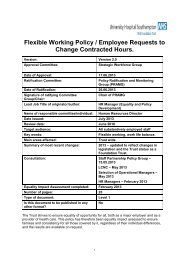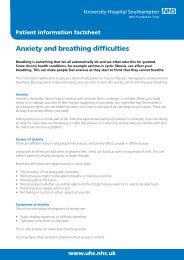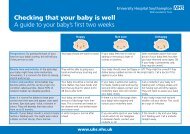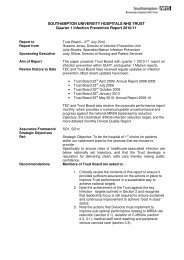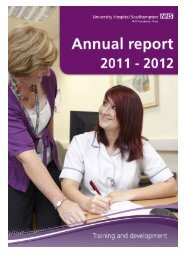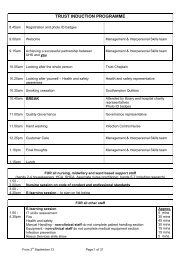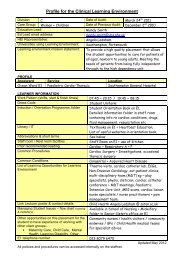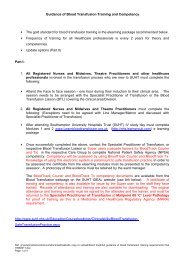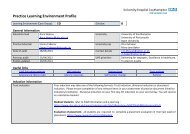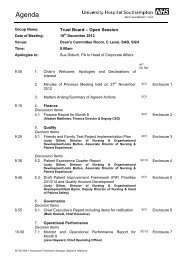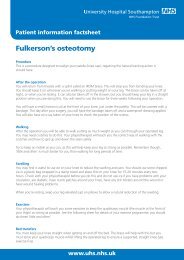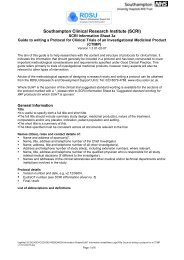ninety years of service - University Hospital Southampton NHS ...
ninety years of service - University Hospital Southampton NHS ...
ninety years of service - University Hospital Southampton NHS ...
- No tags were found...
Create successful ePaper yourself
Turn your PDF publications into a flip-book with our unique Google optimized e-Paper software.
and supported by others with specialist status, all <strong>of</strong> whom had given their <strong>service</strong>s entirely voluntarily, were graduallyreplaced by nearly whole time specialist consultants. Considering the magnitude <strong>of</strong> these changes they took placeremarkably smoothly with very little acrimony.Dr George Ormiston (1947) and Dr Mary Capes (1948) had both joined the staff <strong>of</strong> the hospital prior to the ‘AppointedDay’ and I was appointed Consultant Paediatrician in November 1949. Like Dr Ormiston,I had responsibilities inWinchester as well as <strong>Southampton</strong>. At that time most consultant appointments were designated “maximum part-time”i.e.9/11ths, so that we were able to have some private practice, In my case this never amounted to very much and laterwhen it was permissible, I opted to go full time. An important feature in those days was the Domiciliary Consultation whichwas quite a formal affair with the G.P. nearly always present. As well as being a valuable perk for the consultant they didgive him a chance to meet the G,P,s and also an opportunity for him to see the inside <strong>of</strong> the patients homes,At the Children’s <strong>Hospital</strong> in 1950 Miss Golay was matron and there were two main wards. Ward I. Gillespie, was dividedinto two sections the main one in the front overlooking Winchester Rd. had beds along one side and cots along the outerand there was also the ‘balcony’, which had previously been enclosed, providing 20 beds in all. In 1951 cubicles wereconstructed along one side <strong>of</strong> the ward with the loss <strong>of</strong> 5 beds. At the top <strong>of</strong> the stairs opposite the ward kitchen there wasa small treatment room with a side ward for skin cases next door. The poor babies with generalised eczema there werenursed naked with their limbs splinted to prevent scratching and painted all over with Gentian Violet. Next to the wardkitchen there was a two-bedded sick bay for nursing staff which later became the treatment room: a severe case <strong>of</strong>tetanus was successfully nursed there for several weeks. Nursing procedures were still quite primitive. With no CentralSterile Supply <strong>service</strong> all instruments etc had to be sterilised on the wards. Urine specimens from infants were collectedby means <strong>of</strong> a glass bird feeder strapped on with ‘Elastoplast’ under the nappy.At the back was Ward II, Obree, which accommodated 11 surgical and 12 ‘clean’ medical cases, Dr Ormiston’s smallgastro-enteris ward on the ground floor with Sister Hughes in charge had six cubicles. Dr Ormiston liked to have aspecimen <strong>of</strong> each baby’s stool on display in an enamel pie-dish at the foot <strong>of</strong> its cot, One nurse has complained that thisput her <strong>of</strong>f rice pudding for life! Dr Ormiston retained sole charge <strong>of</strong> the unit until he retired.Ward I was presided over by Sister “Bunty” Boyce a wonderful person in the very best traditions <strong>of</strong> her pr<strong>of</strong>ession. Shewould <strong>of</strong>ten be found still on duty late at night when one <strong>of</strong> her ‘treasures’ was in danger. She was adored by the childrenas well as by their parents. The whole hospital was delighted when later she was awarded an M.B.E. in recognition <strong>of</strong> herdevoted <strong>service</strong>. She retired in 1966.In 1948 12 children (900 p.a.) were still being admitted to Ward I for Ts& As on alternate days but this ceased with the opening <strong>of</strong> the children’sE.N.T. ward at the General. In the fifties infections such as poliomyelitis,congenital syphilis and tuberculosis were still quite common. There wasusually at least one case <strong>of</strong> TB meningitis requiring daily intrathecalinjections <strong>of</strong> streptomycin in the wards. Miliary tuberculosis too was notuncommon nor were bone and glandular T.B. due to the bovine bacillus.Although most town milk was pasteurised, this <strong>of</strong>ten did not apply inrural districts. Gastro-enteritis was still the dreaded complication forhospitalised infants.In most winters there was an epidemic <strong>of</strong> acute infantile laryngotracheo-bronchitis.Sometimes this almost overwhelmed our facilities.Every available cot would be occupied by a wheezing baby whileoccasionally some had to be accommodated temporarily in odd boxes or drawers. Steam kettles and oxygen tents wereeverywhere. The infant’s condition could deteriorate extremely quickly and it was always difficult to decide just when tocall in the E.N.T.surgeon to do a tracheostomy. One has vivid memories <strong>of</strong> Mr Alex Rusell, himself a severe asthmatic,arriving in haste at the top <strong>of</strong> the stairs by Ward I wheezing as badly as the infant he had come to treat!Cystic fibrosis had only recently been separated <strong>of</strong>f from coeliac disease and most <strong>of</strong> the cases died in infancy. Thesweat test had not yet been invented. The cause <strong>of</strong> coeliac disease itself was still a mystery so that there was no effectivetreatment. Cases <strong>of</strong> ‘pink disease’ were still quite common. These were particularly miserable babies with characteristicitchy pink palms and soles. The condition disappeared as soon as it was shown to have been caused by mercurypoisoning from so-called ‘teething powders’. Childhood diabetes was much less common than it is to-day and there weretwo schools <strong>of</strong> thought regarding the importance <strong>of</strong> strict dietary control.We had very little to <strong>of</strong>fer the unfortunate children with malignant disease. Those with various solid tumours had surgeryand probably radiotherapy at the Royal South Hants <strong>Hospital</strong> but those with leukaemia were usually sent home with aprognosis <strong>of</strong> only a few weeks to live, <strong>of</strong>ten to be readmitted in their terminal phase. A development in the late fifties wasthe gradual appreciation <strong>of</strong> the importance <strong>of</strong> non-accidental injury to children; with hind-sight it was apparent that manysuch cases had been missed, sometimes being mis-diagnosed as infantile scurvy.The streptococcal related disorders <strong>of</strong> acute nephritis and rheumatic fever were quite common. In both cases they weretreated by graduated bed rest .The progress was very gradual, starting in the case <strong>of</strong> rheumatic fever, with three weeksflat on the back without pillows. After a week or so at Winchester Rd the children were transferred to Bursledon so that



